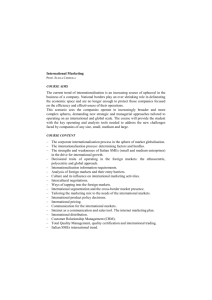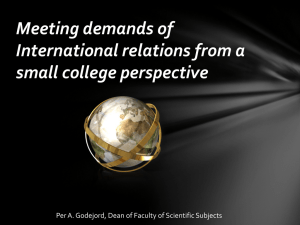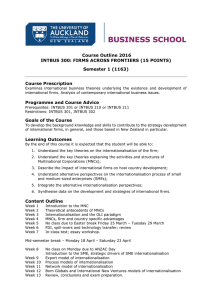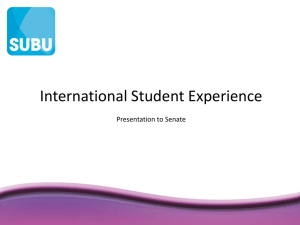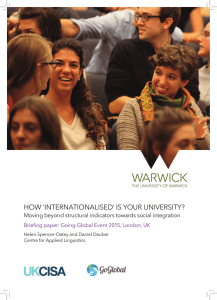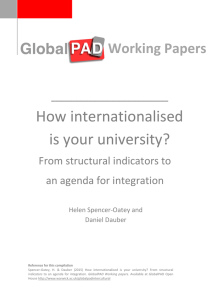Global Education Profiler (GE-P)
advertisement
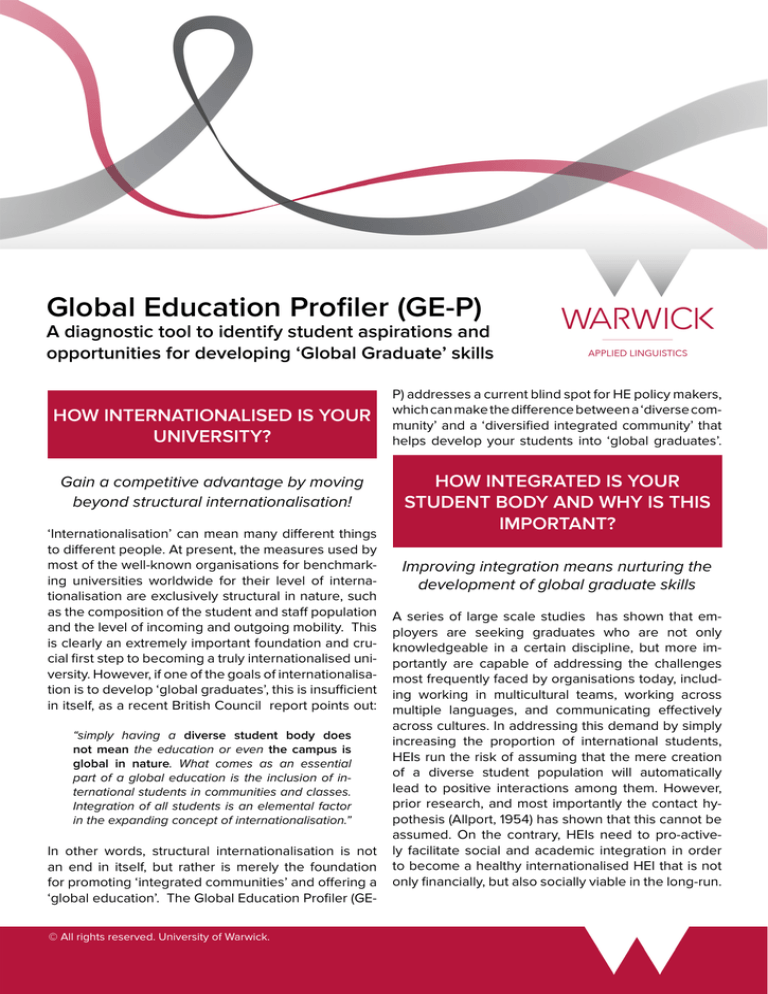
Global Education Profiler (GE-P) A diagnostic tool to identify student aspirations and opportunities for developing ‘Global Graduate’ skills HOW INTERNATIONALISED IS YOUR UNIVERSITY? Gain a competitive advantage by moving beyond structural internationalisation! ‘Internationalisation’ can mean many different things to different people. At present, the measures used by most of the well-known organisations for benchmarking universities worldwide for their level of internationalisation are exclusively structural in nature, such as the composition of the student and staff population and the level of incoming and outgoing mobility. This is clearly an extremely important foundation and crucial first step to becoming a truly internationalised university. However, if one of the goals of internationalisation is to develop ‘global graduates’, this is insufficient in itself, as a recent British Council report points out: “simply having a diverse student body does not mean the education or even the campus is global in nature. What comes as an essential part of a global education is the inclusion of international students in communities and classes. Integration of all students is an elemental factor in the expanding concept of internationalisation.” In other words, structural internationalisation is not an end in itself, but rather is merely the foundation for promoting ‘integrated communities’ and offering a ‘global education’. The Global Education Profiler (GE© All rights reserved. University of Warwick. P) addresses a current blind spot for HE policy makers, which can make the difference between a ‘diverse community’ and a ‘diversified integrated community’ that helps develop your students into ‘global graduates’. HOW INTEGRATED IS YOUR STUDENT BODY AND WHY IS THIS IMPORTANT? Improving integration means nurturing the development of global graduate skills A series of large scale studies has shown that employers are seeking graduates who are not only knowledgeable in a certain discipline, but more importantly are capable of addressing the challenges most frequently faced by organisations today, including working in multicultural teams, working across multiple languages, and communicating effectively across cultures. In addressing this demand by simply increasing the proportion of international students, HEIs run the risk of assuming that the mere creation of a diverse student population will automatically lead to positive interactions among them. However, prior research, and most importantly the contact hypothesis (Allport, 1954) has shown that this cannot be assumed. On the contrary, HEIs need to pro-actively facilitate social and academic integration in order to become a healthy internationalised HEI that is not only financially, but also socially viable in the long-run. FROM ‘DIVERSITY‘ TO ‘INTEGRATED DIVERSITY‘ PLANNING STRATEGICALLY WITH A RELIABLE DIAGNOSTIC TOOL Use the Global Education Profiler (GE-P) – a diagnostic tool for internationalising HEIs How the Global Education Profiler can inform your internationalisation strategy In order to transition from a policy of ‘diversity’ to a policy of ‘integrated diversity’ and ‘global graduate’ development, it is necessary to monitor systematically your university’s current progress towards deeper internationalisation. This can be done by measuring social and academic integration, as well as the extent to which students feel they are developing ‘global skills’, including growth in their understanding of what this entails. The Global Education Profiler (GE-P) has been developed to assess these elements in a systematic and reliable manner. It consists of five short modules each of which serves to measure gaps between aspirations and experiences of students in relation to ‘integrated diversity’ and ‘global graduate’ development. In other words, it offers evaluation measures of both ‘supply’ and ‘demand’, rather than just student satisfaction. The GE-P measures not only the current level of social and academic integration but also opportunities for developing global graduate skills. The ‘supply’ and ‘demand’ design reveals your institution’s strengths and weaknesses, enabling you to prioritise effort and optimise your internationalisation endeavours. The tool allows for contextualised decisions that are meaningful to policy makers, not only in terms of overall student satisfaction, but also with respect to resource allocation and overall improvement in the social viability of your institution. Given the design of the diagnostic tool it is also ‘forward looking’, by capturing students’ aspirations, which makes it a particularly powerful instrument. GE-P offers measures of: • Students’ level of aspiration for integrating into the educational community; • Students’ level of aspiration for developing ‘global graduate’ skills; • Students’ perceived experience of integrating into the educational community; • Students’ perceived experience of developing ‘global graduate’ skills; • The size and direction of any gap between students’ aspirations and experiences. Aims of GE-P: • Measurement of current levels of social and academic integration • Measurement of current levels of ‘global graduate’ development opportunities • Optimisation of resource allocation • Tracking of performance and impact of integration and ‘global graduate’ development initiatives Leading to… • Increase in student satisfaction • Increase in graduates with global skills and greater employability ABOUT THE DEVELOPERS: Prof. Helen Spencer-Oatey, Helen.Spencer-Oatey@warwick.ac.uk Helen’s research explores the construct of Intercultural Competence. She is particularly interested in effective communication, sensitive rapport management and adaptation strategies. Her current projects include the development of resources to promote intercultural competence and underpinning research into the internationalisation of education and the ways in which culture may (or may not) influence behaviour. Dr. Daniel Dauber, d.dauber@warwick.ac.uk Daniel’s research focuses on Organisational Diagnostics, covering areas of Organisational Behavior, International Management and Intercultural Communication. He is interested in organisational pathologies and coherence in light of organisational change, culture and communication. His latest large-scale projects include research on internationalisation of HEIs and intercultural communication in the construction industry. © All rights reserved. University of Warwick.
